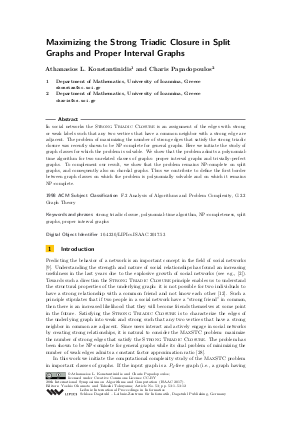Maximizing the Strong Triadic Closure in Split Graphs and Proper Interval Graphs
Authors Athanasios L. Konstantinidis, Charis Papadopoulos
-
Part of:
Volume:
28th International Symposium on Algorithms and Computation (ISAAC 2017)
Part of: Series: Leibniz International Proceedings in Informatics (LIPIcs)
Part of: Conference: International Symposium on Algorithms and Computation (ISAAC) - License:
 Creative Commons Attribution 3.0 Unported license
Creative Commons Attribution 3.0 Unported license
- Publication Date: 2017-12-07
File

PDF
LIPIcs.ISAAC.2017.53.pdf
- Filesize: 0.51 MB
- 12 pages
Document Identifiers
Subject Classification
Keywords
- strong triadic closure
- polynomial-time algorithm
- NP-completeness
- split graphs
- proper interval graphs
Metrics
- Access Statistics
-
Total Accesses (updated on a weekly basis)
0Document
0Metadata
Abstract
In social networks the Strong Triadic Closure is an assignment of the edges with strong or weak labels such that any two vertices that have a common neighbor with a strong edge are adjacent. The problem of maximizing the number of strong edges that satisfy the strong triadic closure was recently shown to be NP-complete for general graphs. Here we initiate the study of graph classes for which the problem is solvable. We show that the problem admits a polynomial-time algorithm for two unrelated classes of graphs: proper interval graphs and trivially-perfect graphs. To complement our result, we show that the problem remains NP-complete on split graphs, and consequently also on chordal graphs. Thus we contribute to define the first border between graph classes on which the problem is polynomially solvable and on which it remains NP-complete.
Cite As Get BibTex
Athanasios L. Konstantinidis and Charis Papadopoulos. Maximizing the Strong Triadic Closure in Split Graphs and Proper Interval Graphs. In 28th International Symposium on Algorithms and Computation (ISAAC 2017). Leibniz International Proceedings in Informatics (LIPIcs), Volume 92, pp. 53:1-53:12, Schloss Dagstuhl – Leibniz-Zentrum für Informatik (2017)
https://doi.org/10.4230/LIPIcs.ISAAC.2017.53
BibTex
@InProceedings{konstantinidis_et_al:LIPIcs.ISAAC.2017.53,
author = {Konstantinidis, Athanasios L. and Papadopoulos, Charis},
title = {{Maximizing the Strong Triadic Closure in Split Graphs and Proper Interval Graphs}},
booktitle = {28th International Symposium on Algorithms and Computation (ISAAC 2017)},
pages = {53:1--53:12},
series = {Leibniz International Proceedings in Informatics (LIPIcs)},
ISBN = {978-3-95977-054-5},
ISSN = {1868-8969},
year = {2017},
volume = {92},
editor = {Okamoto, Yoshio and Tokuyama, Takeshi},
publisher = {Schloss Dagstuhl -- Leibniz-Zentrum f{\"u}r Informatik},
address = {Dagstuhl, Germany},
URL = {https://drops.dagstuhl.de/entities/document/10.4230/LIPIcs.ISAAC.2017.53},
URN = {urn:nbn:de:0030-drops-82113},
doi = {10.4230/LIPIcs.ISAAC.2017.53},
annote = {Keywords: strong triadic closure, polynomial-time algorithm, NP-completeness, split graphs, proper interval graphs}
}
Author Details
References
-
A. B. Adcock, B. D. Sullivan, and M. W. Mahoney. Tree decompositions and social graphs. Internet Mathematics, 12:315-361, 2016.

-
L. Backstrom and J. Kleinberg. Romantic partnerships and the dispersion of social ties: a network analysis of relationship status on facebook. In Proceedings of CSCW 2014, pages 831-841, 2014.

-
F. Bonomo, G. Durán, and M. Valencia-Pabon. Complexity of the cluster deletion problem on subclasses of chordal graphs. Theoretical Computer Science, 600:59-69, 2015.

-
A. Brandstädt, V. B. Le, and J. Spinrad. Graph Classes: A Survey. Society for Industrial and Applied Mathematics, 1999.

-
M. Cochefert, J.-F. Couturier, P. A. Golovach, D. Kratsch, and D. Paulusma. Parameterized algorithms for finding square roots. Algorithmica, 74:602-629, 2016.

-
D.G. Corneil, H. Lerchs, and L.K. Stewart. Complement reducible graphs. Discrete Applied Mathematics, 3:163-174, 1981.

-
B. Courcelle. The monadic second-order logic of graphs i: Recognizable sets of finite graphs. Information and Computation, 85:12-75, 1990.

-
X. Deng, P. Hell, and J. Huang. Linear-time representation algorithms for proper circular-arc graphs and proper interval graphs. SIAM J. Comput., 25:390-403, 1996.

-
D. Easley and J. Kleinberg. Networks, Crowds, and Markets: Reasoning About a Highly Connected World. Cambridge University Press, 2010.

-
J. Edmonds. Paths, trees and flowers. Canad. J. Math., 17:449-467, 1965.

-
M.C. Golumbic. Trivially perfect graphs. Discrete Mathematics, 24:105-107, 1978.

-
M. Granovetter. The strength of weak ties. American J. of Sociology, 78:1360-1380, 1973.

-
M. Grötschel. Polynomial algorithms for perfect graphs. North-Holland Mathematics Studies, 21:325-356, 1984.

-
P. Heggernes, D. Lokshtanov, J. Nederlof, C. Paul, and J. A. Telle. Generalized graph clustering: recognizing (p,q)-cluster graphs. In Proceedings of WG 2010, pages 171-183, 2010.

-
J. E. Hopcroft and R. M. Karp. An n^5/2 algorithm for maximum matchings in bipartite graphs. SIAM J. Comput., 2:225-231, 1973.

-
L. Ibarra. The clique-separator graph for chordal graphs. Discrete Applied Mathematics, 157:1737-1749, 2009.

-
M. O. Jackson. Social and economic networks. Princeton University press, vol. 3, 2008.

-
R. M. Karp. Reducibility among combinatorial problems. Complexity of Computer Computations, pages 85-103, 1972.

-
D. J. Kleitman and R. V. Vohra. Computing the bandwidth of interval graphs. SIAM J. Disc. Math., 3:373-375, 1990.

-
L. C. Lau. Bipartite roots of graphs. ACM Transactions on Algorithms, 2:178-208, 2006.

-
L. C. Lau and D. G. Corneil. Recognizing powers of proper interval, split, and chordal graphs. SIAM J. Disc. Math., 18:83-102, 2004.

-
V. B. Le. Gallai graphs and anti-gallai graphs. Discrete Mathematics, 159:179-189, 1996.

-
V. B. Le, A. Oversberg, and O. Schaudt. Polynomial time recognition of squares of ptolemaic graphs and 3-sun-free split graphs. Theoretical Computer Science, 602:39-49, 2015.

-
P. J. Looges and S. Olariu. Optimal greedy algorithms for indifference graphs. Computers &Mathematics with Applications, 25:15-25, 1993.

-
M. Milanič and O. Schaudt. Computing square roots of trivially perfect and threshold graphs. Discrete Applied Mathematics, 161:1538-1545, 2013.

-
J. L. Pfaltz. Chordless cycles in networks. In Proceedings of ICDE Workshops 2013, pages 223-228, 2013.

-
F. S. Roberts. Indifference graphs. In Proof Techniques in Graph Theory, Academic Press, New York, pages 139-146, 1969.

-
S. Sintos and P. Tsaparas. Using strong triadic closure to characterize ties in social networks. In Proceedings of KDD 2014, pages 1466-1475, 2014.

-
J. Ugander, L. Backstrom, and J. Kleinberg. Subgraph frequencies: Mapping the empirical and extremal geography of large graph collections. In Proceedings of WWW 2013, pages 1307-1318, 2013.

